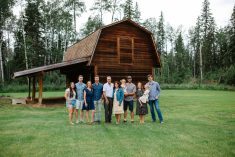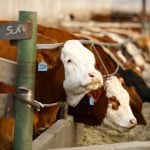Farmers Kevin and Nancy have three children: Jessica, Andrew and Doug.*
Andrew and his wife have been farming in partnership with his parents for 12 years now, and the family is beginning to develop a farm succession plan.
Doug has been working with his parents and brother for a few years, drawing a wage, and isn’t sure if he wants to farm with his brother or start a farm of his own some day.
Jessica is married with a family of her own, has moved away from the farm and hasn’t expressed any interest in the farm — until now.
Read Also

Risk management for the farm means considering people, too
Wheat fields in New Brunswick, Canada.
Both Doug and Jessica are concerned the succession plan will create an uneven inheritance and want to make sure they get what they believe to be “their share” of the farm. As a result, tension is running high between the three siblings, and Kevin and Nancy feel they are caught in the middle.
As parents and the older generation of the farm transition, Kevin and Nancy want to see the farm legacy continue, but at what cost to the relationships between their adult children?
A voice, but no vote
Family farms often involve complex succession planning, especially when parents are uncertain of how to be fair to everyone in the family and are concerned about family harmony.
Siblings often have differing visions for the farm’s future or feel entitled to unequal shares based on their involvement. Uneven inheritance (i.e., one sibling inheriting the farm while others receive less) can create long-lasting tension, especially if non-farming siblings feel excluded.
Darrell Wade, founder of Farm Life Financial Planning Group and a farm succession specialist, offers his insights about managing this sticky sibling situation.
Wade says that this family is already off to a good start by informing everyone of the intention to develop a succession plan. He recommends they start with an initial discovery meeting with an advisor so everyone involved can get a better understanding of their vision of success.
He says it’s always best to remove any assumptions of what everyone wants and believes is needed to be successful in their individual lives and for the farm. Wade believes it’s important that everyone is allowed to have a voice, but they may not necessarily have a vote.
“Most parents want to be able to support all their children if they have the available resources to do so,” says Wade. “But a substantial financial planning analysis should be conducted first to determine the lifestyle income needs of the exiting generation and the financial strength of the farm and family before determining ‘fair’ financial amounts for other siblings.”
He says that depending on the age and stage of life of the off-farm siblings, they may require different types of support (e.g., school tuition, first home, vehicles, etc.). The parents also need to consider balancing their financial needs with what to give their children and/or with the available cash flow of the farm.
“A key part of our recommended planning process also involves identifying goals and quantifying what the farm and family can afford to balance needs and abilities,” Wade says. “For example, I would recommend the family look at various financial tools, such as life insurance policies, that can name non-inheriting siblings as beneficiaries to offset the value of the farm being inherited by one sibling.
“Other considerations could be a ‘right of first refusal’ clause, allowing siblings to buy out the farm or shares before they are offered to anyone outside of the farm. No matter how the family proceeds with the succession plan, communication will be essential to maintain harmony.”
Next, Wade says he would introduce options that could allow the family to weigh the advantages or disadvantages of changing the current structure of the farm (e.g., from a sole proprietor to a partnership or corporation). This would allow the family to clearly define a value for the exiting and entering generations and it can help balance a sibling’s ownership percentage based on their contributions.
“A new ownership structure should also include an agreement to outline how the business will manage unforeseeable situations, like a partner death, disability or disagreement,” Wade says, noting that it’s essential for farmers to always use written contracts, consult an attorney who specializes in agricultural law to ensure contracts are legally binding, and to account for local regulations.
Wade reminds everyone that once the succession plan has been established, it can’t just sit on a shelf. “The plan, wills and agreements should be revisited every few years or after major life events (e.g., marriages, new children, divorce) to reflect changing contributions or goals, or potential new outcomes,” he says.
In the next instalment of this series, we look at the case of Andrea who has been farming alongside her parents for three years. In addition to day-to-day farm work, she’s been investing in the large grain operation by introducing and running new management systems, taking courses to learn more about marketing crops and has invested financially in the expansion of the farm’s grain storage.
Recent conversations between her brother Rob, who isn’t actively involved in the farm and lives off the farm, and her parents have left Andrea with the impression that her brother is weighing in on farm management decisions and wants the farm to be managed his way in an effort to preserve it for his own kids. This has Andrea worried that she will be overlooked in any farm transition and “squeezed out” by her non-farming sibling despite all her work and obvious efforts to grow the farm business.
Watch for it in the December Goal Setting issue.
*This family and case study are fictional.
















